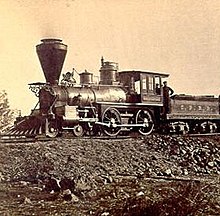In the 1850s, tracks for the New Orleans, Jackson & Great Northern Railroad were laid on the high ground between the Tickfaw and Tangipahoa River basins, took a straight shot south through the swamps of the Isthmus of Manchac then went across the Labranche marshes to the city. It was worth all the effort, for wherever a railroads went, economic prosperity followed. As people moved into an area, towns were established and commerce could commence.
Railroads at this time were still a relatively young technology; the nation’s first had been built only twenty years before. Steam locomotives were evolving from being little more than a tiny boiler on an open flatcar and were taking on the familiar characteristics of a classic nineteenth century locomotive – a cattle catcher and lantern in front of a long cylindrical boiler, big traction wheels underneath, a funnel-shaped stack on top and an engineer house and coal car in back. Over the next century steam engines would become the huge, sleek transcontinental machines our parents and grandparents rode behind but in 1854 the equipment was still limited in performance.
One of these limitations was just how far you could go on a boiler-full of water. You could tote plenty enough coal but the machine would “chuff” away its water as steam as it went, limiting their range to just a few miles at a time. To prepare for this eventuality and to efficiently “refuel” the locomotive, water wells were dug at intervals along the track and water stored in tanks suspended on stilts high enough above to quickly dump into the engine’s boilers to replenish them. Since the train was stopped, it was an opportunity for an enterprising farmer to conduct a little commerce. This lead to trackside freight platforms, conveniently built at the same height of a railcar (a New Orleans invention!). These popped up alongside the water well and tank and often became the nucleus of many of the towns that grew up and down the tracks. Look at the map Tangipahoa Parish’s towns and notice they’re not only concentrated along the rail corridor but are also located at somewhat regular distances between each other – about the distance of a boiler-full of water. Even some of the long gone settlements in the swamps south of Ponchatoula, ghosts on the Manchac Greenway like Strader, Jena, Owl Bayou, Sharkey, Wagram and Ruddock, etc. – had a well and a train stop. The tiny settlements that grew here were where a farmer could load his cabbages for market or even take a ride out of the swamp for a day in the city.
The railroad has long abandoned this old micro-economic model of serving our communities and today almost exclusively pass through the area to provide long haul transportation for big industries but their legacy and tracks are still here.

